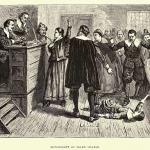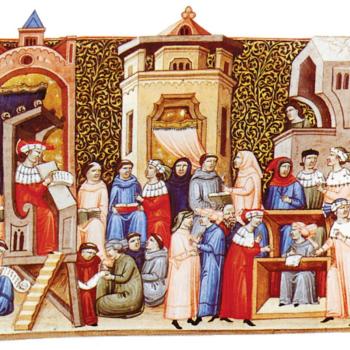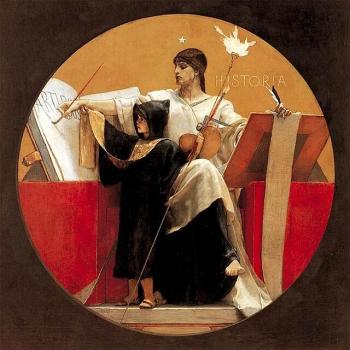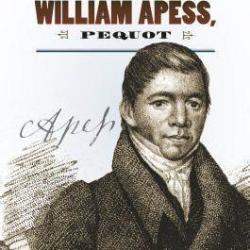The first time it happened I thought it was a fluke, a funny self-referential New England thing: a few years ago in my elder daughter’s high-school American lit class, she was assigned to read Arthur Miller’s The Crucible in fresh fall, the part of the semester when texts should barely have crested the eighteenth century. We then were living north of Boston, in the same county as the Salem that gave popular name to the infamous witch trials, where most regional historic sites that are not Minuteman-themed try to tie in witchcraft in some way, because it’s good for business. What was this 1953 play doing in the colonial America curriculum? The teacher, who was herself an alum of this very high school, explained that it was helpful for students after reading about Puritans to have an interpretive view of them from a later period, and also that Miller’s text worked well for reading aloud. She was winsome. I believed her. Sure, it makes sense that an Essex-county high-school class reads The Crucible after they have read John Winthrop and William Bradford, Anne Bradstreet and Cotton Mather. And sure, students can understand how the 1692 Salem affair could have popped to mind as an apt Red-Scare parallel: attentive Massachusetts high-school students, with years of Adamses and Revere-rides under their belts, already confidently assume that all the highlights of U.S. history somehow start from or circle back to the Hub.
But when my middle child started American lit in an Indiana high school a few weeks back, and had cracked The Crucible before even August had come to an end, something seemed deeply amiss. The only writing assignment before this was an origin myth modeled on Native American ones. An Edward Taylor poem slipped in, and my daughter mentioned something mysteriously named the Young Puritan’s Code that turned out to be Jonathan Edwards’s list of self-disciplines. (Not the Edwards text I would have chosen if only choosing one, but better for this use than the Enfield Sermon.) After that, The Crucible. I did necessary table-talk as before with the older child– you know this is not actually writings of Puritans, this is literature and not history of Massachusetts or Salem witch trials, this is in fact literature employing this historical event as critique of the author’s circumstances of Cold War so it is really about that period and not 1692—and my daughter nodded along. The unit persisted. I contacted the teacher.
The teacher recognized the play as historical fiction, justified its position on grounds that the text carried ample annotation explaining characters’ resemblance to real life as well as acknowledgement that literary imperatives, not history, were driving the drama. That is, the book told students that some of what actually happened was different from what Miller portrayed. Still, she explained, the text had value in showing “what Puritan life was like.”

This high-school class is hardly an outlier. Online searches for The Crucible criticism bristle with offerings from Shmoop, Sparknotes, CliffsNotes, and GradeSaver, attesting to its status as a fixity in the high-school canon. Perhaps part of its current appeal to teachers comes from its utility in addressing Common Core expectations. Associating the text with these standards seems not only to have entrenched it the more firmly in reading lists but contributes to the racket of supporting documents that profit by helping students approach (or avoid) the play while helping teachers cover it efficiently. One Common-Core aligned guide touts pre-packed Crucible quizzes and activities, entries on “The New England Primer” and the “Tragic Hero,” because as “a busy teacher, you don[‘]t have time to waste reinventing the wheel…you need to get down to the business of teaching!” The inertia behind this accretion of teaching- and study-aids keeps The Crucible apparatus rolling, to let pass smoothly along through the early American unit.
These teachers, of course, know this is not a Puritan text. But it would be so easy for students to think so. After all, they mostly know little about either 1690s Massachusetts or 1950s Washington and Hollywood. Miller’s use of Salem witchcraft as metaphor for House Un-American Activities Committee (HUAC) interrogations only resonates if they actually know both sets of events. Only then can they consider the fitness of one as means of indicting the other. To be sure, the play is not just about Salem or HUAC, but about timeless themes pitting individuals against power structures and conscience against and authority, pairing private sins and public guilt. Furthermore, curriculum fashions in high-school teaching can prioritize critical thinking rather than specific texts. But the texts for this kind of class, proceeding with chronological as well as thematic order, must attend to the particulars of time and place and not go timeless too early lest they confuse students for whom the chronology is still foggy. Reading The Crucible as illustrative of colonial Massachusetts plays too much into the unfortunate tendency, endemic in the teaching of early US history at early grade levels, to boil down this whole peculiar people’s experience to Plymouth Thanksgiving and Salem witches.
Still, students’ familiarity with colonial New England events is like a hulking granite monument compared to their understanding of period’s texts. If sophomores or juniors arrived adept at lining out Cotton and Hooker, wondering at Winthrop and Wigglesworth, perhaps they could read meaning in the space between those texts and Arthur Miller’s imaginative script. That seems rather too much to assume. The substitution of Miller for Mather et al is all the more galling given how much good colonial New England writing actually exists. If these settlers had been laconic men and women, supplying the defect with The Crucible might be understandable. But these people left behind thousands of pages, written records capturing voices of lay person and governor and minister, some of whom seem barely ever to have stopped writing except to talk or to listen to someone else talking. There is way too much New England literature. But lacking familiarity with these texts or these times, students likeliest fall to telescoping the contentious, conscientious career of the Massachusetts Bay Colony into the hanging of witches, and to conflating The Crucible with early American lit.
This play has been a fixture in high-school lit curricula a long time. Having it in the curriculum is not by itself the problem. Some teachers might teach it very well. The problems come more with its use, and it seems to me easier to use poorly than not. I, too, read The Crucible as a sophomore or junior, in the waning years of the Cold War, in a high school with peace-activism clubs and nuclear-freeze clubs meeting afterschool. It was explained to me that Miller’s play referenced Joseph McCarthy, about whom I did not know much but whose bogeyman notoriety made sense in terms of the political presuppositions of the classroom. It made sense that a playwright would claim Salem to show the dangers of hysterical efforts to purge Communists-I-mean-witches. Reading the play arguably put in perspective the dangers of the Red Scare, even if there were something legitimately scary about that other superpower and the fact that we and they had spectacularly redundant annihilative capacities. Insofar as I remember that teaching moment, it could be said that reading the play worked for me. I took to heart that unjust anti-Communist hysteria was somewhat comparable to unjust witchcraft hysteria.
Perhaps my degree of dismay is disproportionate to a short-ish unit in a tenth-grade English curriculum. At bottom, two things are important: that students of U.S. history and religion at pretty much any level understand the development of New England colonies without reducing settlers to caricatured witch-hunters in black hats, and that readers reckon with the complexity, richness, and tensions within these settlers’ writings.













